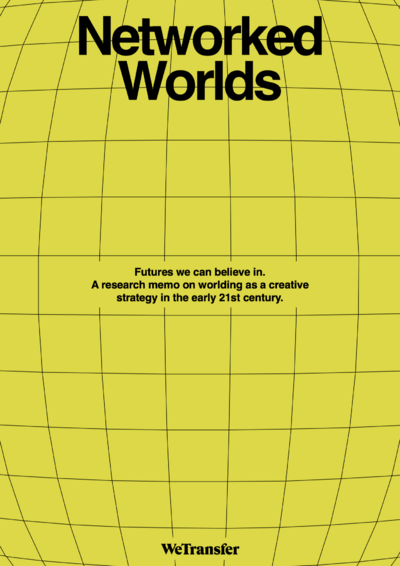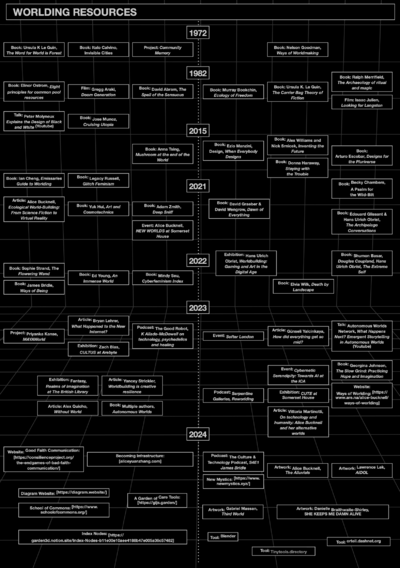[019]
Syntax Magazine
Collaboration
experimental
Syntax is an online magazine using the grammar of the internet. The editors letter of Syntax's first edition reads:
"Digital media promised us new modes of reading. Instead, we got sound bites and “which One Direction member should you date” quizzes. Scrolling online became an experiment in self-defense: we’re bombarded by paywalls and pop-up ads, lured by A/B tested headlines and microtrend pieces. [...]
But no one writes how we read. In chat rooms, comment sections, forums, personal blogs. The video essay, the playlist, Tumblr collage—these forms are as familiar to us as the novel, film, and album. Their words would never reach the true citizens of the internet.."
And so, Syntax provides a honest reflection of what pre-capitalist internet.
“So we go back to the blog. Repurpose the zine. We’re sending our reply using the grammar of the internet.”
25.11.25
[021]
Networked Worlds
Collaboration
experimental
‘Networked Worlds’ focuses on worlding as a creative strategy in the early 21st century. As a response to the multiple crises of our time – a crisis of reality, agency and traditional sensemaking structures – worlding is an emergent creative practice of re-imagining and prototyping alternative futures.
Hyper aware of the rules and power structures of dominant narratives and infrastructures, worlding has become a vital strategy for artists and creatives to experiment with alternative futures and render the conditions of the present visible in order to change them. Worlding as such is different from worldbuilding. While the latter has been established by writers, directors, set designers in creating believable imaginary worlds (think Star Wars, Lord of the Rings or the Marvel Universe), worlding signifies the continuous, ever-evolving, collaborative effort of making worlds emerge rather than creating a closed universe by an individual master creator.
Networked Worlds is the third part of Networked Culture, a series of publications that explore the effects of networked technologies on the creative process. The previous two memos of the series are Networked Counterculture (2023) and Networked Reality (2023).
“Worldbuilding is a means to resist complacency and categorization; an affirmation that one can draw new borders (or ends) and declare new logics for life.”
25.11.25
[022]
Pirate Care, a syllabus
Collective
critical
Pirate Care is a research process - primarily based in the transnational European space - that maps the increasingly present forms of activism at the intersection of “care” and “piracy”, which in new and interesting ways are trying to intervene in one of the most important challenges of our time, that is, the ‘crisis of care’ in all its multiple and interconnected dimensions.
These practices are experimenting with self-organisation, alternative approaches to social reproduction and the commoning of tools, technologies and knowledges. Often they act disobediently in expressed non-compliance with laws, regulations and executive orders that ciriminalise the duty of care by imposing exclusions along the lines of class, gender, race or territory. They are not shying risk of persecution in providing unconditional solidarity to those who are the most exploited, discriminated against and condemned to the status of disposable populations.
The Pirate Care Syllabus presents here for the first time is a tool for supporting and activating collective processes of learning from these practices.
“We live in a world where captains get arrested for saving people’s lives on the sea; where a person downloading scientific articles faces 35 years in jail; where people risk charges for bringing contraceptives to those who otherwise couldn’t get them. Folks are getting in trouble for giving food to the poor, medicine to the sick, water to the thirsty, shelter to the homeless. And yet our heroines care and disobey. They are pirates.”
25.11.25
[029]
Girl Online: A User Manual
Individual
social
What happens when a woman goes online? She becomes a girl.
The unwritten contract of the internet, that a user is what is used, extends from the well-examined issue of data privacy and consent to the very selves women are encouraged to create in order to appear. Invited to self-construct as 'girls online', vloggers, bloggers and influencers sign a devil's bargain: a platform on the condition they commodify themselves, eternally youthful, cute and responsibility-free, hiding offline domestic, professional and emotional labour while paying for their online presence with ‘accounts’ of personal ‘experience’. Can a Girl Online use these platforms not only to escape meatspace oppressions, but as spaces for survival, creativity and resistance?
Told via the arresting personal narrative of one woman negotiating the (cyber)space between her identities as girl, mother, writer, and commodified online persona, Girl Online is written in a plethora of the online styles, from programming language to the blog/diary, from tweets to lyric prose, taking in selfies, social media, celebrity and Cyberfeminism.
25.11.25
[032]
Glitch Feminism: A Manifesto
Individual
critical
A new manifesto in cyberfeminism: finding liberation in the glitch between body, gender and technology.
The divide between the digital and the real world no longer exists: we are connected all the time. How do we find out who we are within this digital era? Where do we create the space to explore our identity? How can we come together and create solidarity?
The glitch is often dismissed as an error, a faulty overlaying, but, as Legacy Russell shows, liberation can be found within the fissures between gender, technology and the body that it creates. The glitch offers the opportunity for us to perform and transform ourselves in an infinite variety of identities. In Glitch Feminism, Russell makes a series of radical demands through memoir, art and critical theory, and the work of contemporary artists who have travelled through the glitch in their work. Glitch Feminism shows how the error can be a revolution.
“Within glitch feminism, glitch is celebrated as a vehicle of refusal, a strategy of nonperformance.”
25.11.25
[039]
The SSENSE of Authenticity
Individual
critical
In "the ssense of authenticity" writer Nabi Williams explores the concept of authenticity in the digital age, particularly through analyzing the canadian fashion e-tailer ssense and its popular Instagram account. posting daily on the social media platform, ssense draws from contemporary culture through its use of language, image layout, and cultural references to create promotional content that exists on the thin line between “authentic meme” and marketing material. by investigating this account and social media’s impact on how authenticity is manufactured, communicated, and perceived, this thesis traces how the concept of authenticity has evolved and argues that we now live in a “post-authentic” world, where storytelling and the “authentically inauthentic” reign supreme in place of sincerity and reality.
“The reality is that “authenticity” holds no value. But then again, who wants to engage in reality?”
25.11.25
[041]
I'm Like a PDF but a Girl
Individual
pedagogy
A literary and ethnographic analysis of the Tumblr platform, supplemented by personal experiences, to explore the site's potency as a pedagogical tool. Ester Freider explains.. "I'm Like a Pdf but a Girl originates from my usage of tumblr as a social learning platform during high school, when AFK I had little educational resources surrounding feminist studies, philosophy, and potential leftisms in my high school and so, turned to a network of peers online to educate myself."
“Embrace subjectivity. Nomadologize. Unclog digital neuroses. Reconnect with the ancients. Atomize. Overflow with information. Make love piratic. Plagiarize with the girls. Weave webs of excess. Become a girlblogger.”
25.11.25
[047]
Sublime Heartbreak: Vectors for an Ending of Times
Individual
Speculative
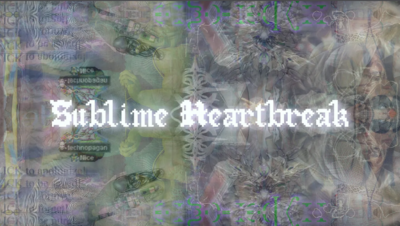
Image by Elizabeth Gabrielle Lee
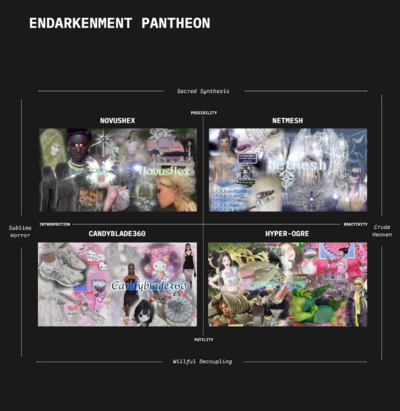
Endarkenment pantheon and its vectors: Possibility ⟷ Futility, Introspection ⟷ Reactivity. The intersection of these vectors (aka quadrants) give rise to aesthetic guilds. Image by Elizabeth Gabrielle Lee
This essay explores the concept of "Endarkenment," an aesthetic response to current global crises. Instead of apocalyptic destruction, Endarkenment finds beauty in chaos and decay. It contrasts traditional enlightenment, emphasizing engagement with darkness and complexity. Four aesthetic "guilds"—NovusHex, Netmesh, Candyblade360, and Hyper-ogre—illustrate different aspects of this concept, embracing both technological and primitive elements to find new forms of meaning and enchantment amid widespread despair and systemic failures.
The essay's concept of "Endarkenment" connects to how we experience fashion online by highlighting emerging digital aesthetics and trends that embrace chaos, complexity, and non-traditional beauty. Online fashion communities reflect this through styles like "indiesleaze" and "ratgirlsummer," which celebrate raw, unpolished looks, and "technomysticism" that merges spirituality with cybernetics. Platforms like Instagram curate these trends, showcasing designs that fuse nature with technology or embrace hyper-femininity and grotesque, anti-minimalist aesthetics. These digital movements redefine fashion by rejecting conventional norms and finding beauty in unconventional, dark, and chaotic expressions.
“I propose Endarkenment, an aesthetic posturing that’s emerging from the abyss of ultimate system failures and chronic mass despair. I’m not interested in a doomsday, pure-nihilistic dystopian narrative.”
25.11.25
[049]
Performing Cyber Tenderness
Individual
social
This text discusses the concept of the "Sad Girl" and its evolution in the digital age. It explores how the internet, particularly platforms like Tumblr, became a space for young women to express their emotions, often through romanticized depictions of sadness and melancholy. The text examines the authenticity and commodification of these emotional performances, as well as the broader societal expectations and pressures placed on women's emotional expression. It also touches on the concept of the "Influencer" and how the pursuit of authenticity has become a tool for capitalist exploitation. The document ultimately suggests that embracing the "Cyborg" and the performative nature of online identity may be a way to resist the commodification of emotion and reclaim digital spaces.
““As you gaze at the flickering signifiers scrolling down the computer screens, (…) you have already become posthuman.””
25.11.25
[050]
Fred Perry x Raf Simons interactive lookbook
Company
commercial

Fred Perry x Raf Simons AW19 by Random Studios
The Fred Perry x Raf Simons SS19 collaboration is presented within an immersive editorial lookbook, honouring an everyday interface familiar to many. Worn by anonymised individuals, the garments can be viewed in a navigable environment, where modified stills create the setting of a universal suburb. Each garment can be examined up-close, with options to view it in situ or in the shop. Location URLs of found garments, sound snippets or visual frames can be shared on social media. The entire campaign can also be viewed as a series of semi-accidental screenshots.
This is the first instalment in a three-part exploration of 360 storytelling. Part two centres around 80s Youth Archive photographs, while part three, 'A Lookbook of Many Gazes', allows the viewer to see the SS20 collection through the eyes of many.
While lookbook offers an examination of the intersection of fashion and digital culture as it immerses the viewer in a hyper-stylised digital environment, utilising motion sensors and abstract imagery to transform familiar, lived experiences into something eerily distant when played out on screen. This dissonance challenges our perceptions of reality, suggesting that the digital mediation of fashion can distance us from the authenticity of human experience, making the familiar strangely unsettling.
25.11.25
[051]
Towards A Minor Tech (Peer-reviewed newspaper)
Collaboration
critical
Following a process of open exchanges and a three-day research workshop in London, at London South Bank University and King’s College, London, this publication brings together researchers who address the problems of technological scale, thinking through the potentials of 'the minor'; or what we are referring to as minor (or minority) tech – small tech that operates at human scale (more peer to peer than server-client) and stutters in its expression and application. As Marloes de Valk puts it in the Damaged Earth Catalog: “Small technology, smallnet and smolnet are associated with communities using alternative network infrastructures, delinking from the commercial Internet.” As such, the publication sets out to question the universal ideals of technology and its problems of scale, extending it to follow the three main characteristics identified in Deleuze and Guattari's essay (Toward a Minor Literature), namely deterritorialization, political immediacy, and collective value.
“we're exploring how technological scale sets conditions for relations, feelings, democratic processes, and infrastructures.”
25.11.25
[054]
The Balkanization & Babelification of the Internet
Collaboration
social
This essay explores the fragmentation of the internet, likened to the "Balkanization" and "Babelification" of online spaces. As the unified digital world splits into smaller, private communities, distinct languages and cultures emerge, leading to communication breakdowns when different groups interact. This splintering mirrors the biblical Tower of Babel story and poses challenges to shared understanding. The authors argue that deeper human connection, especially through physical touch, is essential to overcoming these divides and fostering genuine communication.
The essay's discussion of the internet's fragmentation can be linked to online fashion cultures, where digital spaces have become increasingly niche and isolated. Just as the internet splinters into distinct communities with their own languages and norms, fashion subcultures online—like streetwear, high fashion, or vintage—develop their own unique styles, terminologies, and identities. This fragmentation can both foster strong in-group connections and create barriers to broader communication and understanding between different fashion communities, mirroring the challenges of "Babelification."
“When we return to the public squares, it is not uncommon to think: what the hell is anyone saying? Imagine explaining what an 'Aesop Soap Guy' or a 'Sandy Liang Girlie' are to someone who isn't involved in that discourse.”
25.11.25
[055]
Welcome to the Swarm
Individual
social
On the internet, we are part of swarms: networks of people, bots, and content, coordinated through algorithmic feedback loops. Swarms spread misinformation, help each other, and represent the public. This is not our grandparents' crowd. Swarms are networks of people and information. They can act together without set rules. This research looks at different swarms, like the response to Hurricane María, to see how they work together. We also need to look at other online groups to understand swarms better. These groups have rules that make them easier to manage.
The concept of "swarms" can be connected to the online fashion landscape by considering how decentralized, collective behaviors emerge in digital spaces. In fashion, swarms can be seen in how trends develop, spread, and evolve without a centralized authority. Social media platforms, influencer culture, and digital communities act as nodes in a network where fashion trends are collectively shaped, shared, and adopted. These swarms enable rapid shifts in consumer preferences, allowing niche styles to become mainstream almost overnight, reflecting the fluid and adaptive nature of digital fashion ecosystems.
“In a swarm, the whole emerges from local interactions, with no central control or singular direction. This phenomenon can be seen in digital spaces where collective behaviors and patterns emerge organically, driven by the actions and decisions of individual participants.”
25.11.25
[063]
Embodying the browser
Collaboration
experimental
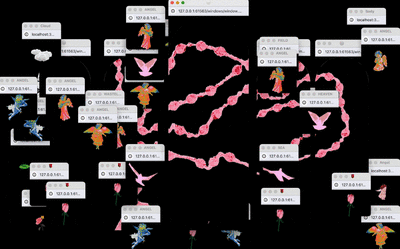
Chia Amisola, Himala, 2024, hypertext website. Courtesy of the artist.
An interview between Meg Miller and Chia Amisola on the development of her practice; from creating browser based environments to translating them into physical performances of the 'ambient internet'. Chia and Meg delve into the concept of embodying the browser as a personal and performative space, transforming websites into lived, immersive experiences. They explore how reading becomes a creative act, akin to authorship, and examines how writing can exist fluidly within data structures, blending code and narrative. With themes of ritual, religion, and repetition, Amisola sees the internet as a potent tool for activism and cultural expression, wielding it as a platform to advance the Filipino struggle and amplify underrepresented voices in the digital age.
I’m interested in reconfiguring our attention to the web: What is visible, invisible, foregrounded? How does poetry emerge from the landscape of the browser?
In this conversation, Amisola explores the agency inherent in 'embodying' technology, where her poetic, chaotic and calming performances reveal how online spaces can become canvases for self-creation, transformation and sharing. Her work in Internet art performance highlights the potential of digital spaces as extensions of (cultural) identity.
Amisola's approach to digital embodiment can critically inform how we view fashion as a social system in online spaces. By 'authoring' identity - through online fashion, words or images - the digital self can become both publisher and platform, forever shifting, growing, shrinking as an evolving interface.
“If Ursula K. Le Guin described technology as the “active human interface with the material world,” I also attempt to become a technology myself.”
25.11.25
[066]
Moodbored
Individual
critical
Olivia Linnea Rogers explores the rise of digital mood boarding as a modern form of identity exploration and creative expression. Originally physical collages, mood boards have evolved online, becoming aspirational but intangible collections of lifestyle aesthetics. It reflects on how images once rare and precious are now curated endlessly on platforms like Pinterest, shaping identity through associations with unattainable ideals. Rogers suggests mood boarding reflects consumerism, escapism, and a desire for curated self-expression, raising questions about authenticity in digital self-construction.
“There is no place for self-actualisation like the Internet. To put on and take off identities, personalities, interests, and styles with no cost at all and by simply lifting a pointer finger. This has generally been considered an advantage of the Internet. I’d argue it is not. It feeds an instinct that has been trained in us from marketing executives. You can create a “self” and a “space” for that self, with none of it being real at all.”
25.11.25
[069]
BUFFER: on fashion, world building and our bodies
Academia
pedagogy
A playlist of talks given during the BUFFER summit organised by MA Fashion Media & Communication at the London College of Fashion (UAL).
In his opening remarks, Dr. Daniel Felstead highlights the growing influence of fashion and gaming in today's cultural landscape, particularly in the context of societal shifts and the decline of traditional art forms. Both industries excel in world-building, blending economic, social, and aesthetic elements into immersive narratives. The convergence of gaming's interactive environments and fashion's diverse media outputs reflects and momentarily escapes today's chaotic realities. Fashion is increasingly being viewed as a form of "world-building technology," as evidenced by collaborations such as Balenciaga's forays into gaming. This cultural shift and growing relationship between these sectors raises questions about how such immersive worlds influence our identities, bodies and societal roles in this period of transformation.
“If World building has become a central mode of cultural production today, then what kind of subjectivities and bodies will it demand?”
25.11.25
[071]
Memestrilism
Individual
critical
Memestrilism is a term made up of "meme" and "minstrelsy" used to describe minstrel-like behaviours, trends and creations in digital spaces. Produced by artist Ama Ogwo as part of the first Feminist Internet Residency, the film critically examines how racism persists in the digital age, paralleling contemporary online representations of blackness with historical racist imagery. Using found footage from social media and 20th-century minstrel shows, Ogwo collapses time to reveal how the ventriloquism of blackness online mirrors and reinvents what minstrelsy looks like today.
The concept of Memestrilism offers a critical lens on the current online zeitgeist, particularly in fashion, by highlighting how cultural appropriation and racial stereotyping continue to manifest in digital spaces. In fashion, the commodification of black culture often intersects with the 'meme economy' of social media, where trends are amplified, decontextualised and stripped of their origins for mass consumption.
The digital landscape thrives on 'hypervisibility', where cultural markers are presented as bold statements, but often lack the necessary cultural nuance. Often Black cultural expressions - hairstyles, clothing styles, linguistic expressions and aesthetics - are showcased through influencers or memes that gain widespread appeal, often without reference to their roots. This parallels historical minstrelsy, where black identity was caricatured and exploited for entertainment. The digital age exacerbates this by enabling the rapid dissemination and monetisation of these trends, further blurring the line between homage and exploitation.
Ogwo's exploration of memestrilism not only critiques, but also reflects the larger conversations taking place in digital fashion spaces about authenticity, representation and the ethics of appropriation in a globalised, meme-driven culture.
25.11.25
[074]
Your Internet Browser Does Not Belong to You
Individual
critical
In the The WIRED article Showler explores how browsers not only serve as gateways to the internet but also influence the way we think, act, and are surveilled online. It examines how features like tabs and private search, initially intended to enhance user experience, reflect and shape our fractured attention spans and desire for privacy. However, the browser’s underlying mechanics, such as tracking and personalized responses to user behavior, expose the tension between browsing as a free, casual act and its deep ties to commercial and surveillance interests. Ultimately, it argues that browsers subtly dictate how we interact with digital spaces, challenging notions of neutrality and autonomy in online environments.
“To use a browser is, directly or indirectly, to participate in commerce. No act of browsing is ever really idle.”
25.11.25
[075]
Internet Real Life (IRL), hosted by Katherine Dee & Peter Limberg
04.04.25
25.11.25
